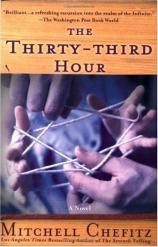The Thirty-third Hour
Review
The Thirty-third Hour
Former Rabbi Moshe Katan takes center stage again in Mitchell
Chefitz's second novel, THE THIRTY-THIRD HOUR, which is the story
of a community exposed to a new way of practicing their religion
and a catastrophic morals charge against Katan.
Rabbi Arthur Greenberg is the leader of "Temple Emet, the largest
Liberal Jewish congregation in greater Miami." He is preoccupied
and worried about a hearing that will either allow the synagogue to
build and expand, or not. In the middle of this mind numbing
tension, he must spend a Memorial Day weekend, alone in his office,
evaluating the "evidence" against Moshe Katan, who is accused of
molesting a young autistic boy.
The Rabbi has been given a collection of videotapes, audiotapes and
a journal that he must get through in only thirty-three hours; then
he's expected to make his plea before the building commission and
also render a decision about Katan's behavior before the
complainant goes to the police to report the alleged crime.
But Moshe is an old classmate, albeit out of touch with Greenberg
for twenty-five years. As memories of their earlier friendship
surface, Arthur is torn between old loyalties and the scandal
brewing under his nose. Who, he asks, is to blame for the
violations chronicled in the piles of evidentiary materials if not
himself? "The fault was mostly his … he professed no serious
interest [in the program] … he was satisfied with a polite
response [to the occasional query into how the program was
proceeding] … there had been no need for him to do anything
more than be polite."
Less than halfway through viewing and listening to the tapes, Rabbi
Greenberg perceives Moshe Katan as a cult leader. He is clearly an
enigmatic free thinker whose freewheeling and unconventional
approach to Judaism is rooted in both the Torah and the Kabala. His
mission is to bring families together to "act" their religion in
order to fully understand to whom they pray and why. He encourages
the adults and children to ask questions about what they read in
bible stories and the sacred texts. This is threatening to even the
most liberal of Rabbis like Arthur Greenberg.
At the same time Katan is a sexy, eligible widower who sends out
pheromones in the same seductive way flowers send out fragrance. Of
course his eligibility doesn't go unnoticed by some of the eligible
and not so eligible women in the congregation. He, however, seems
far more interested in the children, especially Daniel who suffers
from a rare form of autism.
Overall Rabbi Greenberg's "awakening" and "consciousness raising"
arise from the objectivity he brings to the task of hearing and
watching how Katan teaches the families in the Havura (study
group). Through the hours of focused attention on all of the
"evidence", Greenberg begins to understand his own life, his own
shortcomings, his own devotion to his calling and his own
gifts.
Chefitz presents all of this in a very interesting, thought
provoking narrative that provides readers an opportunity to
re-examine their own beliefs. The Bible stories as acted out by the
members of the Havura are wonderful to re-read in this form. They
adapt themselves to discussion within the frames of the novel and
overflow into the reader's life for further exploration.
Readers do not have to be Jewish to grasp the essence of THE
THIRTY-THIRD HOUR. This novel will appeal to anyone interested in
Bible study; traditional and alternative approaches to interpreting
Bible stories; the social and spiritual fulfillment that comes from
belonging and that springs from commitment to religious study; and
the lessons one can learn from opening themselves to new
ideas.
Reviewed by Barbara Lipkien Gershenbaum on January 23, 2011
The Thirty-third Hour
- Publication Date: January 15, 2003
- Genres: Fiction
- Paperback: 288 pages
- Publisher: St. Martin's Griffin
- ISBN-10: 0312303238
- ISBN-13: 9780312303235




